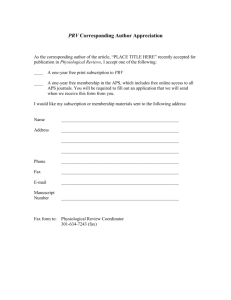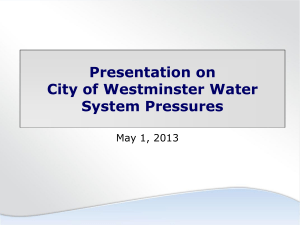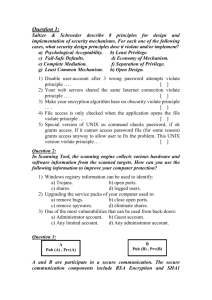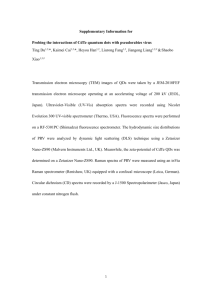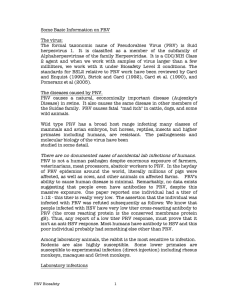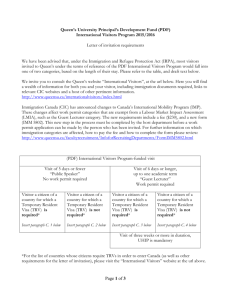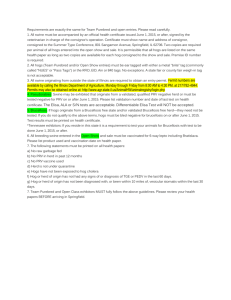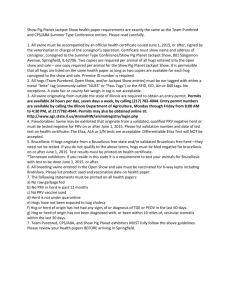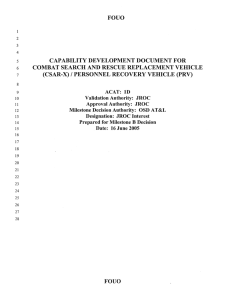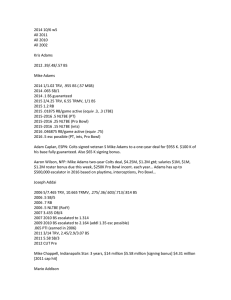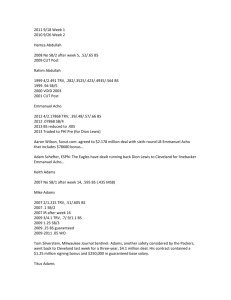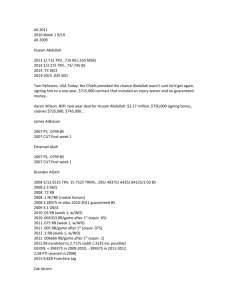Compressibility Factor and Pressure
advertisement
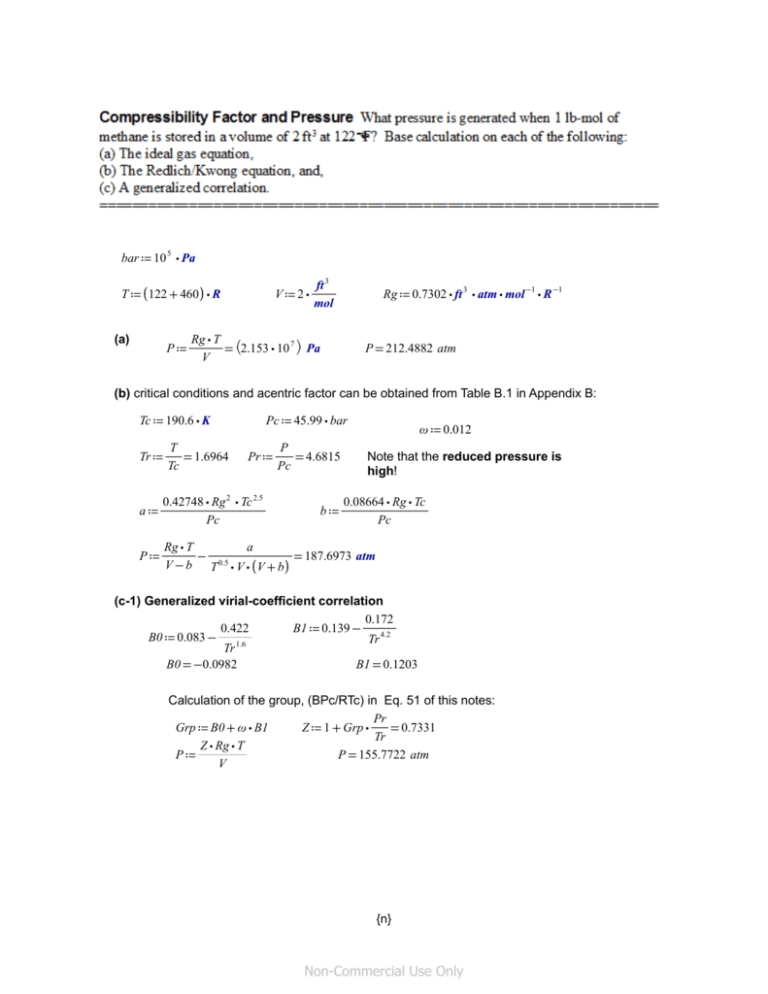
bar ≔ 10 5 ⋅ Pa
ft 3
V ≔ 2 ⋅ ――
mol
T ≔ (122 + 460) ⋅ R
(a)
Rg ⋅ T
P ≔ ――= ⎛⎝2.153 ⋅ 10 7 ⎞⎠ Pa
V
Rg ≔ 0.7302 ⋅ ft 3 ⋅ atm ⋅ mol −1 ⋅ R −1
P = 212.4882 atm
(b) critical conditions and acentric factor can be obtained from Table B.1 in Appendix B:
Tc ≔ 190.6 ⋅ K
T
Tr ≔ ―= 1.6964
Tc
Pc ≔ 45.99 ⋅ bar
P
Pr ≔ ― = 4.6815
Pc
0.42748 ⋅ Rg 2 ⋅ Tc 2.5
a ≔ ――――――
Pc
ω ≔ 0.012
Note that the reduced pressure is
high!
0.08664 ⋅ Rg ⋅ Tc
b ≔ ―――――
Pc
Rg ⋅ T
a
P ≔ ――− ―――――
= 187.6973 atm
0.5
V − b T ⋅ V ⋅ (V + b)
(c-1) Generalized virial-coefficient correlation
0.172
B1 ≔ 0.139 − ――
0.422
B0 ≔ 0.083 − ――
Tr 4.2
Tr 1.6
B0 = −0.0982
B1 = 0.1203
Calculation of the group, (BPc/RTc) in Eq. 51 of this notes:
Pr
Grp ≔ B0 + ω ⋅ B1
Z ≔ 1 + Grp ⋅ ―= 0.7331
Tr
Z ⋅ Rg ⋅ T
P = 155.7722 atm
P ≔ ―――
V
{n}
Non-Commercial Use Only
(c-2) Lee/Kesler generalized correlation
Now, we will have to use the linear interpolation technique in MathCad to approach the values of Z0
and Z1 in the Tables E.3 and E.4 in Smith, van Ness, and Abbott (pp.652-653, 5th ed.):
⎡ 3.0 ⎤
Prv ≔ ⎢
⎣ 5.0 ⎥⎦
⎡ 1.6 ⎤
Trv ≔ ⎢
⎣ 1.7 ⎥⎦
These are the points which cover the desired Pr's and Tr's in
the tables.
To interpolate the functional values, Z0(Pr, Tr), we have to conduct 3 sequential interpolation steps:
1) to interpolate the Z0 at Trv=1.6,
2) to interpolate the Z0 at Trv=1.7, and,
3) to interpolate the Z0 at Trv=1.6964 (at theTr).
Step 1: From Table E.1 on p. 652, we obatin the two numbers for Z0 at Trv=1.6, one corresponds to
the Prv=3.0 and the other corresponds to Prv=5.0:
⎡ 0.8410 ⎤
Z01 ≔ ⎢
⎣ 0.8617 ⎥⎦
Then, use linear interpretation to obtain the Z0 at Pr=4.6815 (note that "linterp" is the
built-in commend for linear interpolation in mathCad):
linterp (Prv , Z01 , Pr) = 0.8584
Step 2: Again, from the table on p.652, we obatin the two numbers for Z0 at Trv=1.7, one
corresponds to the Prv=3.0 and the other corresponds to Prv=5.0:
⎡ 0.8809 ⎤
Z02 ≔ ⎢
⎣ 0.8984 ⎥⎦
Then, use linear interpretation to obtain the Z0 at Pr=4.6815:
linterp (Prv , Z02 , Pr) = 0.8956
Step 3: Finally, we have to interpolate the two values in hand to obtain Z0 at Tr=1.6964. To achieve
the goal, let us define a vector consisting the two values we obtained from the last two steps:
⎡ linterp (Prv , Z01 , Pr) ⎤
Z0 ≔ ⎢
⎣ linterp (Prv , Z02 , Pr) ⎥⎦
Then, use linear interpretation to obtain the Z0 at Tr=1.6964:
linterp (Trv , Z0 , Tr) = 0.8943
{n}
Non-Commercial Use Only
To interpolate the functional values, Z1(Pr, Tr), we have to conduct 3 sequential interpolation steps
similar to the procedure for Z0:
1) to interpolate the Z1 at Trv=1.6,
2) to interpolate the Z1 at Trv=1.7, and,
3) to interpolate the Z1 at Trv=1.6964 (at theTr).
Step 1: From Table E.4 on p. 653, we obatin the two numbers for Z1 at Trv=1.6, one corresponds
to the Prv=3.0. and the other corresponds to Prv=5.0:
⎡ 0.2381 ⎤
Z11 ≔ ⎢
⎣ 0.2631 ⎥⎦
Then, use linear interpretation to obtain the Z1 at Pr=4.6815:
linterp (Prv , Z11 , Pr) = 0.2591
Step 2: Again, from the table on p.651, we obatin the two numbers for Z1 at Trv=1.7, one
corresponds to the Prv=3.0 and the other corresponds to Prv=5.0:
⎡ 0.2305 ⎤
Z12 ≔ ⎢
⎣ 0.2788 ⎥⎦
Then, use linear interpretation to obtain the Z1 at Pr=4.6815:
linterp (Prv , Z12 , Pr) = 0.2711
Step 3: Finally, we have to interpolate the two values in hand to obtain Z1 at Tr=1.6964. To achieve
the goal, let us define a vector consisting the two values we obtained from the last two steps:
⎡ linterp (Prv , Z11 , Pr) ⎤
Z1 ≔ ⎢
⎣ linterp (Prv , Z12 , Pr) ⎥⎦
Then, use linear interpretation to obtain the Z1 at Tr=1.1997:
linterp (Trv , Z1 , Tr) = 0.2707
Now, we are in a position to evaluate Z:
Z ≔ linterp (Trv , Z0 , Tr) + ω ⋅ linterp (Trv , Z1 , Tr)
Z = 0.8975
Z ⋅ Rg ⋅ T
P ≔ ―――
V
P = 190.7126 atm
The experimental results shows 185 atm. Both the Lee-Kesler generalized correlation and
Redlich-Kwong give reasonably good results, but the generalized virial correlation and ideal
gas law completely fail at such high pressure.
{n}
Non-Commercial Use Only
